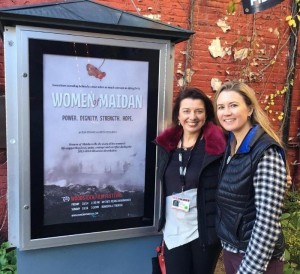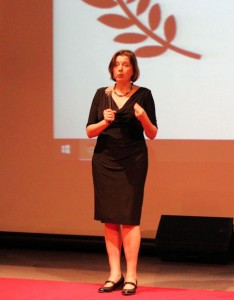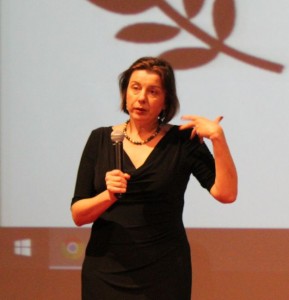‘Women Stand Together’ reveals gender bias as impediment to meaningful conversation
 In March, the Fort Myers Film Festival screened a 66-minute U.S.-made documentary titled Women of Maiden. Produced and directed by Olha Onyshko, the film portrays the critical role that females played (and continue to play) in the Ukrainian struggle for democracy and freedom. The audience learned at the Fort Myers Film Festival’s October T.G.I..M. screenings that Ms. O
In March, the Fort Myers Film Festival screened a 66-minute U.S.-made documentary titled Women of Maiden. Produced and directed by Olha Onyshko, the film portrays the critical role that females played (and continue to play) in the Ukrainian struggle for democracy and freedom. The audience learned at the Fort Myers Film Festival’s October T.G.I..M. screenings that Ms. O lyshko is now working on a documentary about women right here in the United States who are rallying in support of reproductive rights, civil rights, LBGTQIA rights and immigration. The documentary’s working title is Women Stand Together, and hosts Eric Raddatz and Melissa DeHaven treated T.G.I.M. attendees with a sneak peek of a 7-minute
lyshko is now working on a documentary about women right here in the United States who are rallying in support of reproductive rights, civil rights, LBGTQIA rights and immigration. The documentary’s working title is Women Stand Together, and hosts Eric Raddatz and Melissa DeHaven treated T.G.I.M. attendees with a sneak peek of a 7-minute  rough cut of the longer version that Onyshko hopes to complete later this year.
rough cut of the longer version that Onyshko hopes to complete later this year.
Women Stand Together chronicles the Women’s March on Washington that took place the day after President Donald Trump’s inauguration. Although crowd estimates vary, as many as 1 million women staged a kind of counterinauguration on Saturday, January 21. The  march took on a life of its own following a Facebook post shortly after the election that captivated the imaginations of hundreds of thousands of women (and men) across the United States. It culminated in peaceful protests not only in the nation’s capital, but New York, Boston, Atlanta, Denver, Los Angeles, Phoenix, St. Paul, Key West and even some cities abroad.
march took on a life of its own following a Facebook post shortly after the election that captivated the imaginations of hundreds of thousands of women (and men) across the United States. It culminated in peaceful protests not only in the nation’s capital, but New York, Boston, Atlanta, Denver, Los Angeles, Phoenix, St. Paul, Key West and even some cities abroad.
 All totaled, 5 million people marched on January 21 on all seven continents for a more equitable, tolerant, just and safe world in which human rights and the dignity of each person and the safety of the planet is protected.
All totaled, 5 million people marched on January 21 on all seven continents for a more equitable, tolerant, just and safe world in which human rights and the dignity of each person and the safety of the planet is protected.
Olha Onyshko’s documentary focuses exclusively on the Washington march and contains raw footage and woman-on-t he-street interviews shot throughout the course of the day. Although the filmmaker provides some text crawl to introduce and tie film segments together, for the most part she simply allows the footage to tell its own story – much as she did in Women of Maidan, which won Best Documentary honors at last year’s Fort Myers Film Festival.
he-street interviews shot throughout the course of the day. Although the filmmaker provides some text crawl to introduce and tie film segments together, for the most part she simply allows the footage to tell its own story – much as she did in Women of Maidan, which won Best Documentary honors at last year’s Fort Myers Film Festival.
Raddatz and DeHaven relish the opportunity to show controversial films to their film festival and T.G.I.M. a udiences. Raddatz and DeHaven admit both publicly and privately that a successful film in their view is one which gets people thinking and starts conversation. Unsettling, disquieting and troubling content is often an essential ingredient in that recipe, and Women Stand Together was all of that, and more.
udiences. Raddatz and DeHaven admit both publicly and privately that a successful film in their view is one which gets people thinking and starts conversation. Unsettling, disquieting and troubling content is often an essential ingredient in that recipe, and Women Stand Together was all of that, and more.
Stating that women’s rights are human rights and human rights a re women’s rights, the Women’s March on Washington convened a broad and diverse group of leaders to produce an intersectional platform known as the Unity Principles. “ We must create a society in which women – including Black women, Native women, poor women, immigrant women, disabled women, Muslim women, lesbian
re women’s rights, the Women’s March on Washington convened a broad and diverse group of leaders to produce an intersectional platform known as the Unity Principles. “ We must create a society in which women – including Black women, Native women, poor women, immigrant women, disabled women, Muslim women, lesbian  queer and trans women – are free and able to care for and nurture their families, however they are formed, in safe and healthy environments free from structural impediments,” the march’s organizers stated.
queer and trans women – are free and able to care for and nurture their families, however they are formed, in safe and healthy environments free from structural impediments,” the march’s organizers stated.
Among the principles marchers espoused were:
 ending all forms of violence, including police brutality, racial profiling and gender and racially based inequities within the criminal justice system;
ending all forms of violence, including police brutality, racial profiling and gender and racially based inequities within the criminal justice system;- reproductive rights that respect a woman’s access to quality reproductive healthcare services, birth control, HIV/AIDS care and prevention, and medically-accurate sex
 education;
education; - LGBTQIA rights, including the right to be free from gender norms, expectations and stereotypes;
- worker rights, including pay equity, access to affordable childcare, sick days, paid family leave and work environments free from sexual harassment;
- c
 ivil rights, including voting rights, free speech and protections for all citizens regardless of race, gender, age or disability;
ivil rights, including voting rights, free speech and protections for all citizens regardless of race, gender, age or disability; - immigrant and refugee rights regardless of status or country of origin, the same being “rooted in the promise of America’s call for huddled masses yearning to breathe free; and
- the
 right to clean water, clean air, access to and enjoyment of public lands, and the protection of both the environment and climate.
right to clean water, clean air, access to and enjoyment of public lands, and the protection of both the environment and climate.
Taut, compact, raw and edgy, Women Stand Together depicted a broad cross-section of the people who took to the mall and streets of Washington D.C. to advocate for these issues.
At  T.G.I.M. screenings, Raddatz and DeHaven strive to encourage their audiences to engage in dialogue about the films they view. To facilitate the discussion, they empanel local and regional celebrities to judge the films and kick off the discussion by offering their insights and observations. For October, the judging panel consisted of model/actor Dakota Jordan Peoples, musical entertainer and former Platters lead singer Al Holland and Diva Diaries author, radio p
T.G.I.M. screenings, Raddatz and DeHaven strive to encourage their audiences to engage in dialogue about the films they view. To facilitate the discussion, they empanel local and regional celebrities to judge the films and kick off the discussion by offering their insights and observations. For October, the judging panel consisted of model/actor Dakota Jordan Peoples, musical entertainer and former Platters lead singer Al Holland and Diva Diaries author, radio p ersonality, actor and director Stephanie Davis.
ersonality, actor and director Stephanie Davis.
Dakota Peoples was impressed by the way in which the film illustrated how so many different types of people could come together in peaceful protest to make a difference. “I loved how the filmmaker showed that diversity – the different organizations, colors, races, and religions all coming together to peacefully show the choices they wanted to make,” Peoples said. “No two people are the same and we all have to make our own decisions and exercise our rights. The filmmaker really showed that, and we need  more of that in the world right now.”
more of that in the world right now.”
Al Holland liked the film too, but had to confess that he was somewhat distracted from fully absorbing the film’s overarching message by how quickly the text crawled across the screen and some of the costumes worn by the marchers. He was particularly puzzled by a sequence that depicted several women who were sporting flesh-colored mustaches on their upper lips. “Can  anyone tell me what that was all about,” Holland implored the audience. “Ahhhhhhhhhhhhh,” he responded good-naturedly when a female audience member explained that the “mustaches” were fallopian tubes attached to ovaries.
anyone tell me what that was all about,” Holland implored the audience. “Ahhhhhhhhhhhhh,” he responded good-naturedly when a female audience member explained that the “mustaches” were fallopian tubes attached to ovaries.
Stephanie Davis was struck by the inventive and oft-artistic costuming, placards and music the protesters employed. But in her estimation, the real strength of the film was the extent and degree  to which it depicted the support, camaraderie and sense of connection the participants shared. “To see those women gathered together and have each other and have that feeling of camaraderie, of knowing they’re not alone, gave me a warm feeling,” Davis observed.
to which it depicted the support, camaraderie and sense of connection the participants shared. “To see those women gathered together and have each other and have that feeling of camaraderie, of knowing they’re not alone, gave me a warm feeling,” Davis observed.
“It was also a good statement on peaceful protest, which finds itself these days under attack,” she added thoughtfully. “What those women and men  were doing during the Women’s March was peaceful protest and we have to protect that just as we have to protect the right of an NFL player to take a knee to protest racial inequality and police shootings.”
were doing during the Women’s March was peaceful protest and we have to protect that just as we have to protect the right of an NFL player to take a knee to protest racial inequality and police shootings.”
In many, perhaps even most instances, the audience’s observations, insights and comments prove far more enlightening than those offered by the celebrity judges. On this evening, however, what stood out was the  negative reaction uniformly expressed by male audience members and the failure of the women in the audience to counter their sentiments and stand up for the film.
negative reaction uniformly expressed by male audience members and the failure of the women in the audience to counter their sentiments and stand up for the film.
Guy 1 disagreed with Dakota People’s comments about diversity. “Speaking of diversity, it would have been nice to see just one guy. I know it was about the women and needed to be about the women, but diversity cuts both ways.” As a point in fact, several  men were pictured in the footage included in the documentary.
men were pictured in the footage included in the documentary.
Guy 2 stated, “This goes back to Kent State, to Vietnam, and even today with the NFL. You ask three people why you’re protesting and you get three different answers. Same thing with this. Most of these people were there for the party atmosphere and the trip to Washington. The real question is never answered.”
Guy 2 can perhaps be forgiven for not being familiar with the scope and breadth of the Unity Principles being advanced by the Women’s March.  But it is interesting that he would be put off by the ebullience that would naturally arise at a gathering of people who were experiencing a sense of empowerment, validation and esprit de corps, some for the very first time. [The comparison to Kent State, in which 29 members of the Ohio National Guard fired 67 rounds of ammunition into a crowd of unarmed students at a Vietnam War protest, killing four and wounding nine, was curious as the protesters at Kent State had assembled specifically to denounce President Richard Nixon’s expansion of the war into Cambodia several days earlier and the Ohio governor’s attempt to silence them by revoking their permit to assemble on campus on the day of the s
But it is interesting that he would be put off by the ebullience that would naturally arise at a gathering of people who were experiencing a sense of empowerment, validation and esprit de corps, some for the very first time. [The comparison to Kent State, in which 29 members of the Ohio National Guard fired 67 rounds of ammunition into a crowd of unarmed students at a Vietnam War protest, killing four and wounding nine, was curious as the protesters at Kent State had assembled specifically to denounce President Richard Nixon’s expansion of the war into Cambodia several days earlier and the Ohio governor’s attempt to silence them by revoking their permit to assemble on campus on the day of the s hootings.]
hootings.]
The remarks went from the sublime to the ridiculous when Guy 3 took the microphone from Melissa DeHaven. He brought up a 1997 science fiction drama starring Jodie Foster in which her character, Dr. Ellie Arroway, travels through a series of wormholes to a distant galaxy to encounter an alien on a beach who appears to her in the form of her deceased father. “He said to her something very poignant that we need to be cognizant of f rom one end of this country to the other end of this planet: ‘Why can’t you people just get along?’ And that’s the problem. If we all got along, all this BS would stop.”
rom one end of this country to the other end of this planet: ‘Why can’t you people just get along?’ And that’s the problem. If we all got along, all this BS would stop.”
Leaving aside the implication that Guy 3 thinks that what the women who marched on Washington were protesting is bullshit, his comment overlooks the very gravamen of protest movements. What are people supposed to do in the face of tyranny and o ppression? How do you effect political or social change if you are denied the right and ability to voice opposition to an intolerable condition or situation? How can you raise consciousness as the existence and scope of a problem if you cannot assembly peaceably to redress grievances? What would Dr. Martin Luther King, Jr. have said if he’d been told to “just get along, why don’t you?” For that matter, what would Thomas
ppression? How do you effect political or social change if you are denied the right and ability to voice opposition to an intolerable condition or situation? How can you raise consciousness as the existence and scope of a problem if you cannot assembly peaceably to redress grievances? What would Dr. Martin Luther King, Jr. have said if he’d been told to “just get along, why don’t you?” For that matter, what would Thomas  Jefferson, James Madison, Ben Franklin and the other delegates at the Constitutional Convention in Philadelphia had said in the face of such a remark?
Jefferson, James Madison, Ben Franklin and the other delegates at the Constitutional Convention in Philadelphia had said in the face of such a remark?
But at the October T.G.I.M., no one challenged Guy 3 or sought to engage him in a spirited debate over the legitimacy of the positions being advanced by the women, men and children taking part in the Women’s March – if only to point out that what he’d said was tantamount to telling all those protesters that they don’t have a right to feel as  they do.
they do.
Guy 4 damned Women Stand Together with faint praise. “It’s a wonderful collection of footage from before the protest, after the protest and during the march – really, really hard to come by unless you were out there digging for it,” he said. “That’s far and away the most footage from that protest that I’ve ever seen. That’s a wonderful thing …” You guessed it. Then came the qualifier.
“But that being said,” Guy 4 continued, “I’m not sure that the f ilm is much more than raw footage or that the director brought much of anything to it at all.”
ilm is much more than raw footage or that the director brought much of anything to it at all.”
Sorry, Ms. Olyshko, you get no credit for deciding what footage to shoot and which people to interview. You get no credit for deciding which footage to include and which to leave on the editing room floor. You get no credit for determining the order in which to present it, or for the hundreds, perhaps thousands, of other decisions a director/producer must make  when editing a film.
when editing a film.
Guy 5, by contrast, thought the film was “a little too long, too unfocused and overly dramatic.” In other words, he conceded that the filmmaker did make editing choices, he just didn’t care for the decisions that Ms. Olyshko and her team made in filming and assembling the documentary.
Only two female audience members offered comments. Neither took on the foregoing comments head on, although one woman did assert in contradistinction to Guys 4 and 5 that “[Ms. Olyshko] did a really good job piecing the [footage and interviews] to give the viewer the best that she  wanted to give them.”
wanted to give them.”
So what happened? Why did the men in the audience have a negative view of the film while the female viewers were generally impressed? Why did the men and women who spoke up after the film talk past one another like kids on a playground rather than engaging in meaningful dialogue with each other about what they’d just seen and heard?
Perhaps the lesson to be derived from the post-screening  discussion is that before men and women can talk to each other about issues such as reproductive rights, equal pay, gender inequality and sexual harassment/assault, we must first be courageous enough to examine the gender-based biases, political convictions and economic agendas that color our thoughts and perceptions.
discussion is that before men and women can talk to each other about issues such as reproductive rights, equal pay, gender inequality and sexual harassment/assault, we must first be courageous enough to examine the gender-based biases, political convictions and economic agendas that color our thoughts and perceptions.
Just as we must be willing to acknowledge and examine our race-based biases and assumptions before we can engage in a candid and productive conversation about racial issues.
O ne conclusion that can be unequivocally drawn from what transpired following the October T.G.I.M. screening of Olha Olyshko’s Women Stand Together is that we have a lot of work to do before we can talk about gender issues in present-day American culture and society.
ne conclusion that can be unequivocally drawn from what transpired following the October T.G.I.M. screening of Olha Olyshko’s Women Stand Together is that we have a lot of work to do before we can talk about gender issues in present-day American culture and society.
Olha Olyshko has her own production company, OliaFilm, and has worked as a freelance producer, cinematographer and editor for clients including The World Bank, The Global Health Council, DKT International, John Hopkins University, The Down  Syndrome Network of Montgomery County, The National Park Service, and The Center for the Study of the Presidency and Congress.
Syndrome Network of Montgomery County, The National Park Service, and The Center for the Study of the Presidency and Congress.
She has been recognized by both the US Congress and the Ukrainian Embassy for her collaborative efforts to rescue the wounded of Ukraine and bring them to the U.S. for t reatment. Inspired by that rescue operation, along with other events behind the scenes of Women of Maadan, she has begun writing a feature film script called “To Rescue Hope.” Listen to a podcast where Olia talks about this new project
reatment. Inspired by that rescue operation, along with other events behind the scenes of Women of Maadan, she has begun writing a feature film script called “To Rescue Hope.” Listen to a podcast where Olia talks about this new project : http://indieentertainmentpodcast.com/.
: http://indieentertainmentpodcast.com/.
You may contact Olia at oliafilm@gmail.com or at 202-257-7356. The website of her production company is www.oliafilm.com.
October 14, 2017.
- T.G.I.M. returns October 2
- Meet October T.G.I.M. celebrity judge Dakota Jordan Peoples
- Meet October T.G.I.M. celebrity judge Stephanie Davis
- Meet October T.G.I.M. celebrity entertainer Al Holland
 T.G.I.M. audiences focus on meaning and message of indie films
T.G.I.M. audiences focus on meaning and message of indie films- Elijah Green theme song encapsulates anticipation of T.G.I.M. screenings
- T.G.I.M. returns to Davis Art Center on Labor Day
- Mayor Randy Henderson to provide opening remarks at Sept. 4 T.G.I.M.
- J
 ohn Scoular one of T.G.I.M. celebrity judges on September 4
ohn Scoular one of T.G.I.M. celebrity judges on September 4 - Actor/director Stella Zuri joins Sept. 4 T.G.I.M. celebrity judge panel
- Freakshow’s Flyin Brian to provide blunt assessments at T.G.I.M.
- S
 inger-songwriter Chloe Friedman will perform at September 4 T.G.I.M.
inger-songwriter Chloe Friedman will perform at September 4 T.G.I.M. - T.G.I.M. returns to Davis Art Center on August 7
- Filmmaker Tyler Shore sharing judging duties at August 7 T.G.I.M.
- Actress and model Mercedes Gutierrez one of August’s T.G.I.M. celebrity judges
- Jason Parrish one of T.G.I.M. celeb judges for
 August
August - Frankie Colt returns to Davis Art Center for T.G.I.M.
- About the 8th Annual Fort Myers Film Festival















 Tom Hall is both an amateur artist and aspiring novelist who writes art quest thrillers. He is in the final stages of completing his debut novel titled "Art Detective," a story that fictionalizes the discovery of the fabled billion-dollar Impressionist collection of Parisian art dealer Josse Bernheim-Jeune, thought by many to have perished during World War II when the collection's hiding place, Castle de Rastignac in southern France, was destroyed by the Wehrmacht in reprisal for attacks made by members of the Resistance operating in the area. A former tax attorney, Tom holds a bachelor's degree as well as both a juris doctorate and masters of laws in taxation from the University of Florida. Tom lives in Estero, Florida with his fiancee, Connie, and their four cats.
Tom Hall is both an amateur artist and aspiring novelist who writes art quest thrillers. He is in the final stages of completing his debut novel titled "Art Detective," a story that fictionalizes the discovery of the fabled billion-dollar Impressionist collection of Parisian art dealer Josse Bernheim-Jeune, thought by many to have perished during World War II when the collection's hiding place, Castle de Rastignac in southern France, was destroyed by the Wehrmacht in reprisal for attacks made by members of the Resistance operating in the area. A former tax attorney, Tom holds a bachelor's degree as well as both a juris doctorate and masters of laws in taxation from the University of Florida. Tom lives in Estero, Florida with his fiancee, Connie, and their four cats.